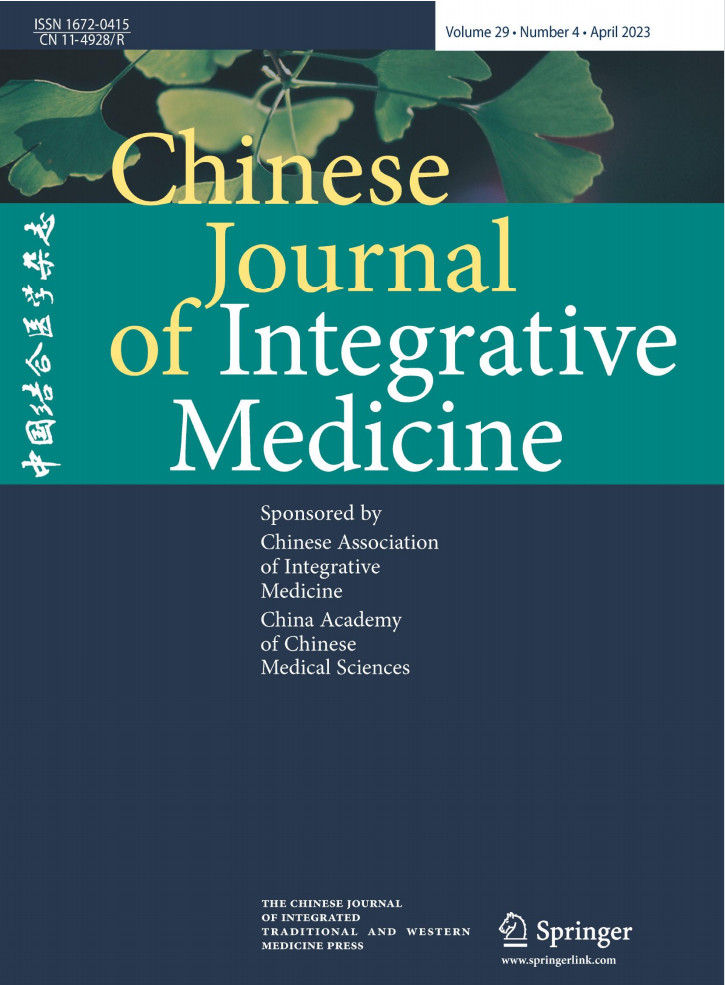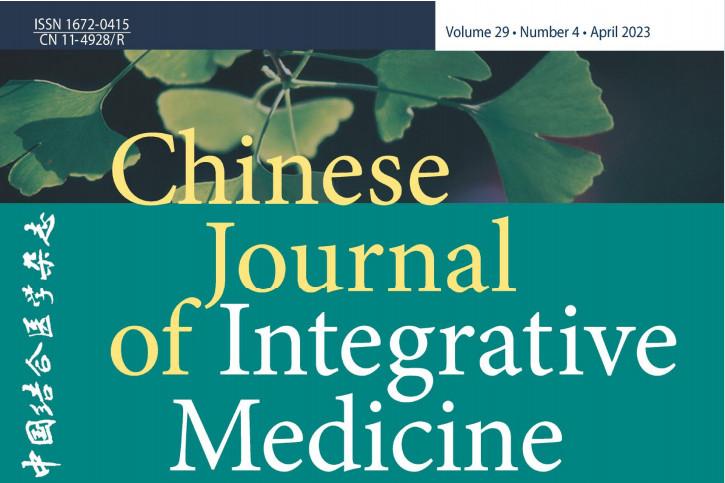中国结合医学杂志英文版
Chinese Journal of Integrated Traditional
Chinese Journal of Integrative Medicine, originally entitled "Chinese Journal of Integrated Traditional and Western Medicine" (English Edition), was founded in 1995, and changed formally its name in 2003. This journal is supervised by State Administration of Traditional Chinese Medicine, sponsored by Chinese Association of Integrative Medicine and China Academy of Chinese Medical Sciences. It is the first international peer-reviewed monthly journal on integrative medicine included in Science Citation Index Expanded (SCI-E).
A comprehensive English language journal covering integrative Chinese and Western medicine
Founded in 1995, and managed by the State Administration of Traditional Chinese Medicine
Reports on scientific developments, experiences and achievements in clinical practice, scientific research, education and healthcare
期刊收录:
中国结合医学杂志英文版投稿需知:
Chinese Journal of Integrative Medicine is a peer-reviewed monthly journal sponsored by Chinese Association of Integrative Medicine and China Academy of Chinese Medical Sciences. It is the first international journal on integrative medicine included in Science Citation Index Expanded (SCI-E).
AIMS & SCOPE
Chinese Journal of Integrative Medicine (‘the Journal’) seeks to promote international communication and exchange on integrative medicine as well as complementary and alternative medicine (CAM), and to provide a rapid forum for the dissemination of scientific articles focusing on the latest developments, trends, experiences and achievements on integrative medicine and CAM in clinical practice, scientific research, education and healthcare.
COLUMN & TOPICS
Editorial
An accompanying comment written by editor-in-chief of the Journal or by an invited specialist regarding representative paper/s in the current issue. The manuscript should be concise and generally between 1,500 and 3,000 words in length.
Perspective
This is mainly solicited by editors of the Journal to provide in-depth viewpoints and comments on current hot topics, issues or news events on integrative medicine and CAM. Manuscripts submitted on authors' own initiative are also welcomed. This manuscript is commonly from 2,000 to 3,000 words.
Commentary
This is a comment generally solicited by editors of the Journal on research progress, direction, issues or strategies in the fields of integrative medicine and CAM. Manuscripts submitted on authors' own initiative are also welcomed and length of manuscript is usually in the range of 2,000 to 3,000 words.
Feature Articles
Each issue of the Journal carries 3 to 4 solicited manuscripts of a special topic on integrative medicine and CAM. These articles are often written by international specialists from different perspectives and are of high academic value. In general, these manuscripts should be of 2,000 to 3,000 words in length.
Original Articles
This is the most important forum for authors to submit their works representing clinical studies and experimental researches. For randomized controlled trials, approval by ethics committee, signed informed consent from each subject and clinical trial registration number must be stated, and the manuscript should be prepared according to CONSORT 2010 and submitted with CONSORT 2010 checklist. As a common practice, original articles should not exceed 5,000 words or 8 printed pages. Should a paper exceed 8 printed pages, the authors will be requested to omit parts of the article, which might be published online as supplementary appendix.
Clinical Experiences
These are generally manuscripts of case series report or clinical experience summary. Although without RCT design, clinical experiences with distinctive characteristics and practicability are welcomed since they might be of great reference value for clinicians of primary care. Manuscripts on clinical experiences are generally of 2,000 to 3,000 words in length.
Case Reports
These are brief reports of individual clinical cases, especially cases difficult-to-treat by conventional medicine means but benefit from integrative medicine with objective evidences (e.g., imaging data, photos of pathology or special physical signs) before and after treatment. The length of these reports should be between 1,500 to 2,000 words.
Evidence-based Integrative Medicine
These are papers of research findings on integrative medicine and CAM in accordance with the principle of evidence-based medicine, especially papers reporting results of multi-center, large-scale RCTs, or systematic reviews and meta-analysis. In general, these manuscripts should not exceed 5,000 words.
Traditional Medicine
This forum introduces traditional medicine around the world, ethno-medicine in China, and their relevant research findings. Manuscripts should be in the range of 2,000 to 4,000 words.
Herb-Drug Interaction
The papers report research findings or reviews of drug interactions between Western medicines and traditional medicine (e.g., herbal medicine). The length of the manuscripts should be in the range of 2,000 to 4,000 words.
Literature Research
These are articles based on classification, summarization, comparison and analysis of available literatures on TCM, integrative medicine and CAM. The manuscripts are usually of 2,000 to 4,000 words in length.
Academic Exploration
These papers elaborate and extend individual viewpoints on a particular issue of integrative medicine and CAM. An issue of controversy is most welcomed, and different representative viewpoints or debates on the same issue will also be published together. These manuscripts are usually in the range of 2,000 to 3,000 words.
Thinking and Method
This provides a platform for new ideas, innovative thinking and hypothesis on integrative medicine and CAM. The editors encourage submission of manuscripts of original innovation which should be between 2,000 to 3,000 words.
Regulation and Guideline
This section aims to introduce the policies and regulations on integrative medicine and CAM established by important international organizations such as WHO, FDA, NCCAM, and to publish or to interpret the most recent guidelines on integrative medicine and CAM. The international guidelines on integrative medicine and CAM established by national or foreign academic societies are most welcomed for publication in the Journal. These manuscripts should be between 2,000 to 4,000 words or so, and not exceed 6,000 words.
Interdisciplinary Knowledge
This forum introduces all kinds of relevant interdisciplinary knowledge that might contribute to the studies on integrative medicine and CAM, including but not limited to systematic biology, proteomics, bioinformatics, data mining, clinical epidemiology, and evidence-based medicine. It is necessary to prepare the manuscript in such a way that it combines an introduction to the interdisciplinary knowledge together with their superiorities, application values and prospects in the research of integrative medicine and CAM. In general, the manuscript should be between 2,000 to 4,000 words.
Reviews
These are systematic and critical assessment of recent literatures on a particular issue of integrative medicine or CAM. The manuscripts should not exceed 5,000 words excluding the abstract and references.
Continuing Education
This is usually in the form of a lecture delivered by an invited specialist on a special topic or on a certain disease for clinicians of integrative medicine and CAM to expand their knowledge base and stay up-to-date on the new developments. The manuscript is usually between 2,000 and 4,000 words.
Conference Proceedings
This is to provide a summary of proceedings of national or international conferences on TCM, integrative medicine and CAM. The manuscript should be in the range of 2,000 to 4,000 words.
Correspondence
This is typically a letter to the editors referring to a recent article, and the editors may invite its authors to write a response. Short letters not about a Journal article may also be considered, but the Journal can publish only a small quantity of them. These manuscripts should contain not more than 1,000 words and strictly up to 10 relevant references.
Prominent Personnel
This column introduces noted specialists and their academic achievements in the field of TCM, integrative medicine and CAM. The specialists are to be selected by the editors and the introductions are to be prepared by the specialists themselves. The manuscript should be between 1,500 and 2,000 words.
Book Review
Book Review recommends and reviews recently published books on TCM, integrative medicine and CAM, especially those in English. Please contact editorial office of the Journal for details. In general, the manuscript should not be more than 1,500 words.
Let You Know
This section disseminates information of global organizations, societies, institutions, universities, colleges, departments, websites, periodicals of integrative medicine and CAM. Please contact editorial office of the Journal for details. In general, the manuscripts should not be more than 1,500 words.
Special Exhibition
Special Exhibition column introduces and make popular outstanding representative products of integrative medicine and CAM, including but not limited to instruments, software, drugs and healthcare products. If possible, the manuscripts should focus on academic theory or rationale instead of just a simple product introduction. Please contact editorial office of the Journal for details. Manuscripts for this column should not be of more than 2,000 words.
Conference Announcement
This section announces in advance international conferences, meetings, courses, awards, and other events on TCM, integrative medicine and CAM. Event organizers are welcomed to contact editorial office of the Journal for details. The announcements should be between 200 and 600 words in length.
ONLINE SUBMISSION
Manuscripts should be submitted to the Journal using the ScholarOne online submission system at http://mc03.manuscriptcentral.com/cjim. Full instructions and support are available on the website where user ID and password could be obtained on the first visit. For assistance, click the link ‘Get Help Now’ at top right of every ScholarOne Manuscript page. For Chinese authors, please refer to http://mc03.manuscriptcentral.com/societyimages/cjim/Author_cn.pdf
REQUIRED FORMS
The manuscripts should be prepared in accordance with the "Uniform Requirements for Manuscripts Submitted to Biomedical Journals: Writing and Editing for Biomedical Publication" (www.ICMJE.org). The manuscripts should be written in English, each copy between 3,000 and 5,000 words. For Chinese authors, please also submit Chinese version of the manuscript if available, as this could be useful to a Chinese reviewer.
Title Page
This page includes the title of the article which should be concise but informative; name of each author in English and Chinese; name of department(s) and institution(s) to which the work was done; address, telephone and fax numbers, and E-mail address of the author responsible for correspondence about the manuscript; and any grant support should be mentioned on this page.
Abstract and Key Words
The abstract (of no more than 300 words) of research articles should consist of four paragraphs, labeled Objective, Methods, Results, and Conclusions. They should state the purpose of the study or investigation, basic procedures, main findings (give specific data and their statistical significance), and the conclusions. This four-part form does not apply to other types of articles. Provide 3-8 key words below the abstract. Use terms from the medical subject headings (MeSH), and the traditional Chinese medical subject headings, present terms may be used.
Text
Introduction: State the purpose of the article. Give a brief, relevant background to the study.
Methods: Describe the subjects (patients or laboratory animals, and the controls, including criteria for selection) clearly. Describe the methods, apparatus and procedures in sufficient detail. Identify precisely all drugs and chemicals used, including generic name(s), dose(s) and route(s) of administration.
Results: Present the results in the text, tables and illustrations concisely, and do not repeat in the text all the data in the tables or illustrations; summarize only important observations.
Discussion: Emphasize the new and important aspects of the study and the conclusions that follow from them. Include the implications of the findings and their limitations, as well as implications for future research. State new hypotheses when warranted, but clearly label them as such.
Tables
Each table should be numbered in sequence using Arabic numerals (i.e. Table 1, 2, 3 etc.). Tables should also have a title that summarizes the whole table, maximum 15 words. Detailed legends may then follow, but should be concise. Smaller tables considered to be integral to the manuscript. Columns and rows of data should be made visibly distinct by ensuring the borders of each cell display as black lines. Double-space tables (including any footnotes) and provide a title for each.
Figures and Illustrations
Medical and scientific illustrations will be created or redrawn in-house. If an outside illustrator has created a figure, the Journal reserves the right to modify or redraw it to meet our specifications for publication. Please describe and clearly indicate all modifications, selective digital adjustments, or electronic enhancements in all digital images. Photographs should be provided as high-resolution component files. For photographs of patients' body parts, written and signed consent of the patient should also be sent or faxed to the editors.
Units of Measurement
Measurement of length, height, weight and volume should be reported in metric units (meter, kilogram, or liter) or their decimal multiples. All hematologic and clinical-chemical measurements should be reported in the metric system in terms of the International System of Units (SI).
Abbreviations and Terminology
Use only standard abbreviations. All abbreviations and acronyms are to be spelled out in full on their first appearance in the text. Avoid abbreviations in the title and key words. Herbs are to be presented by their common, pharmaceutical and pinyin or Latin names. Acupuncture terms are to be conformed to the World Health Organization nomenclature.
Acknowledgements
The role of a medical writer must be included in the acknowledgements section, including their source(s) of funding. Authors should obtain permission to acknowledge from all those mentioned in the Acknowledgements. Please list the source(s) of funding for the study, for each author, and for the manuscript preparation in the acknowledgements section.
References
Number the references consecutively in the order in which they are first mentioned in the text. The form of references should conform to the Index Medicus. List all authors when there are six or fewer; when there are seven or more, list the first six, followed by “et al.” The following are sample references:
1. Sawin CT, Geller A, Wolf PA, Belanger AJ, Baker E, Bacharach P, et al. Low serum thyrotropin concentrations as a risk factor for atrial fibrillation in older persons. N Engl J Med 1994; 331:1249-1252.
2. Zhang HX, Shi ZX, Jia HZ, Li G, Cheng WL, Gu WL, et al. Effects of garlicin on NIH3T3 cell proliferation and collagen synthesis. Chin J Integr Tradit West Med (Chin) 2007;27:431-434.
3. Wellens HJJ, Brugada P, Bar F. Diagnosis and treatment of the regular tachycardia with a narrow QRS complex. In: Klbertus HE, ed. Medical management of cardiac arrhythmias. Edinburgh, Scotland: Churchill Livingstone; 1986:121-132.
On submission you will be asked to provide a cover letter. Please use this to explain why your manuscript should be published in the journal and to elaborate on any issues related to our editorial policies detailed in the instructions for authors. Manuscripts for research articles should be divided into the following sections:
Title page
Abstract
Background or Introduction
Methods
Results
Discussion
Conclusions
List of abbreviations used (if any)
Acknowledgements
References
Figure legends (if any)
Tables and captions (if any)
Publication fee
Authors of accepted articles must pay a publication fee.
Standard page charges: $250-300 USD fee for each page.
Color print page charges: $250 USD fee for color figure (or figure plate).




